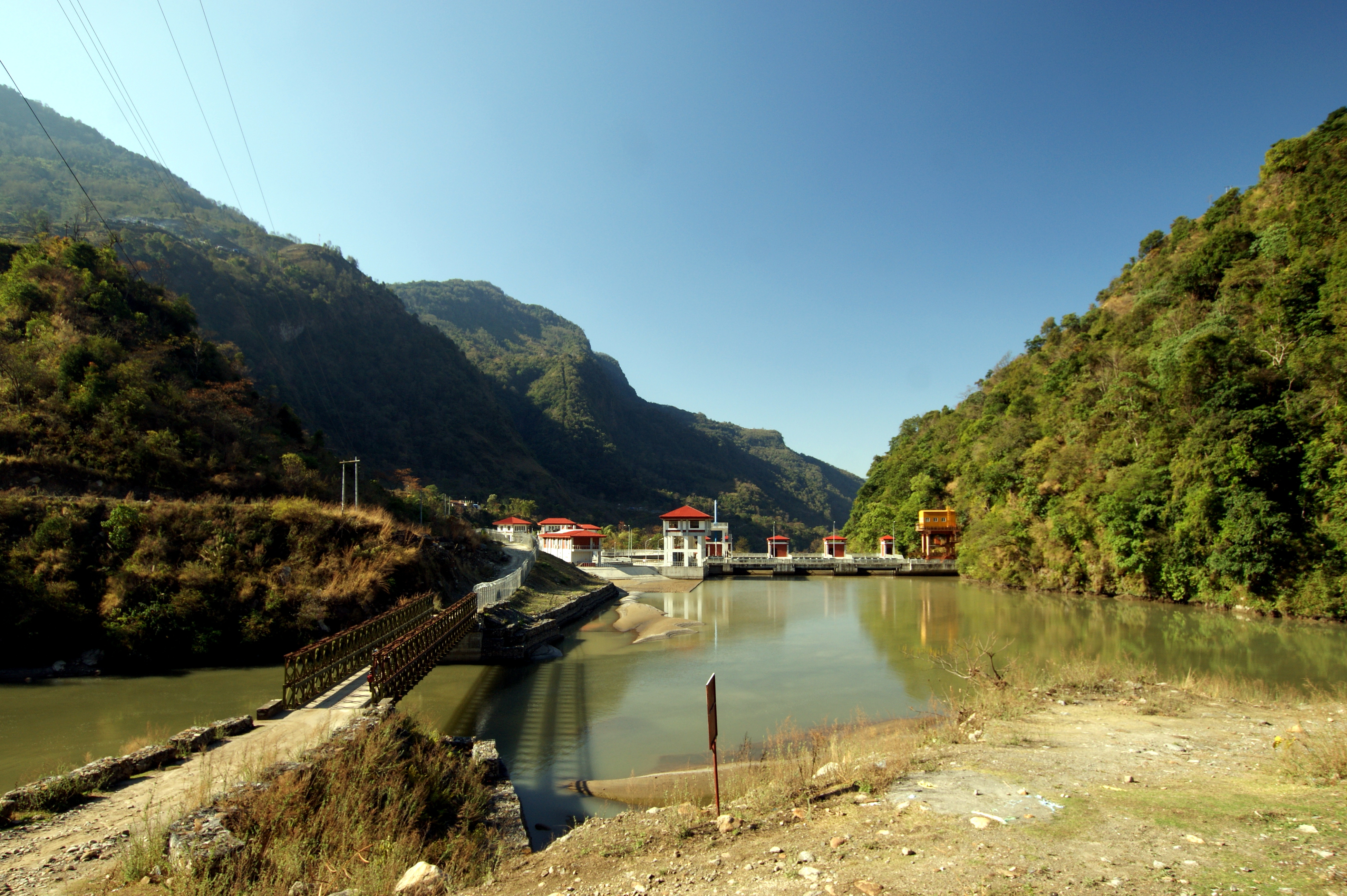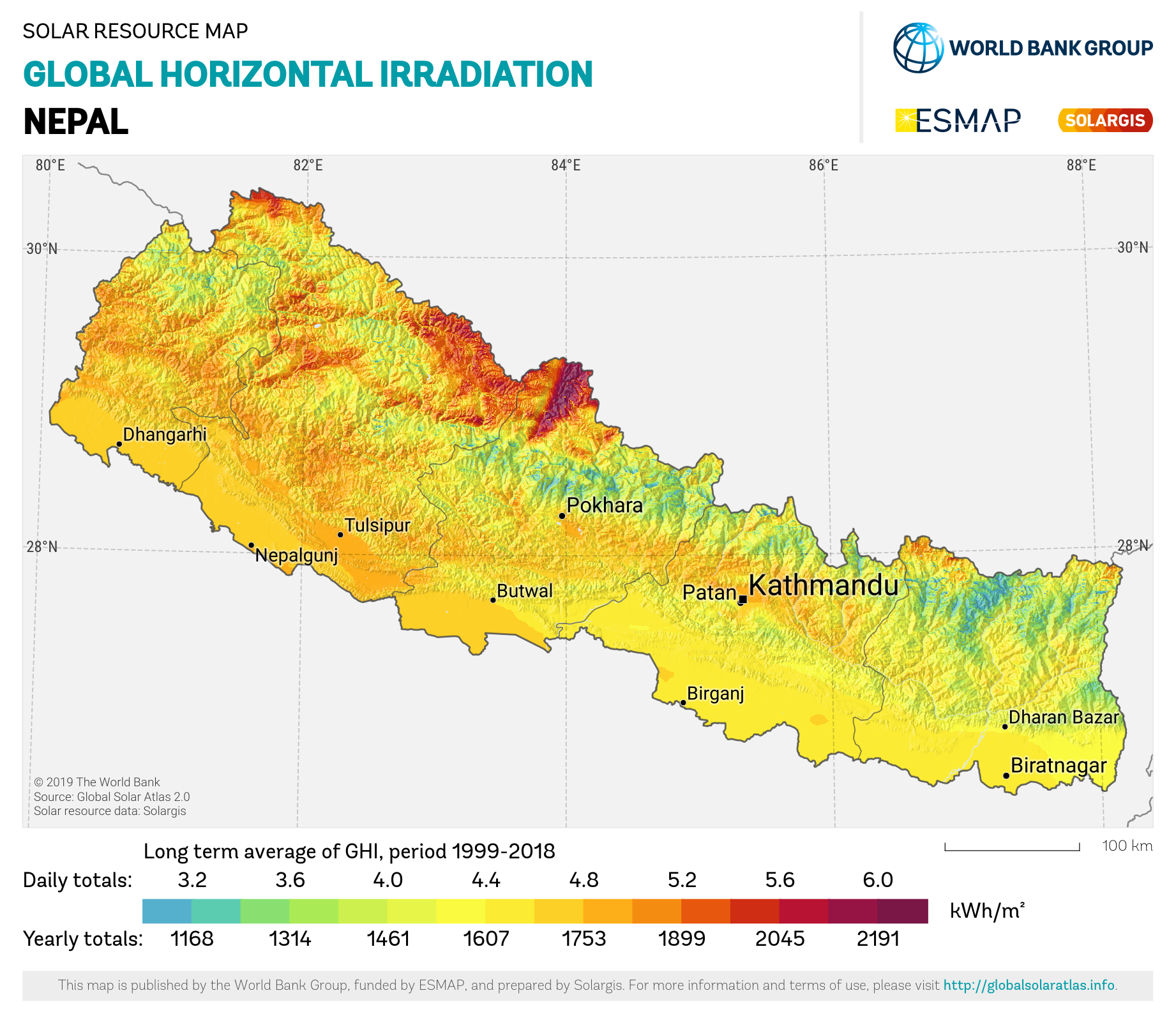Solar Power In Nepal on:
[Wikipedia]
[Google]
[Amazon]

 Nepal gets most of its electricity from hydropower sources, but it is looking to expand the role of solar power in its energy mix. The average global solar radiation in Nepal varies from 3.6-6.2 kWh/m²/day, sun shines for about 300 days a year, the number of sunshine hours amounts almost 2100 hours per year with an average of 6.8 hours of sunshine each day and average insolation intensity about 4.7 kWhm²/day. The commercial potential for a solar power grid is about 2100MW.
Power cuts with an average of 10 hours per day in the past time had been common in Nepal and Nepal Electricity Authority used to publish a time table for power cuts.
Nepal gets most of its electricity from hydropower sources, but it is looking to expand the role of solar power in its energy mix. The average global solar radiation in Nepal varies from 3.6-6.2 kWh/m²/day, sun shines for about 300 days a year, the number of sunshine hours amounts almost 2100 hours per year with an average of 6.8 hours of sunshine each day and average insolation intensity about 4.7 kWhm²/day. The commercial potential for a solar power grid is about 2100MW.
Power cuts with an average of 10 hours per day in the past time had been common in Nepal and Nepal Electricity Authority used to publish a time table for power cuts.

Renewable energy
Renewable energy is energy that is collected from renewable resources that are naturally replenished on a human timescale. It includes sources such as sunlight, wind, the movement of water, and geothermal heat. Although most renewable energy ...
in Nepal
Nepal (; ne, नेपाल ), formerly the Federal Democratic Republic of Nepal ( ne,
सङ्घीय लोकतान्त्रिक गणतन्त्र नेपाल ), is a landlocked country in South Asia. It is mai ...
is a sector that is rapidly developing in Nepal.
While Nepal mainly relies on burning biomass for its energy needs, solar and wind power
Wind power or wind energy is mostly the use of wind turbines to electricity generation, generate electricity. Wind power is a popular, sustainable energy, sustainable, renewable energy source that has a much smaller Environmental impact of wi ...
is being seen as an important supplement to solve its energy crisis. The most common form of renewable energy in Nepal is hydroelectricity
Hydroelectricity, or hydroelectric power, is Electricity generation, electricity generated from hydropower (water power). Hydropower supplies one sixth of the world's electricity, almost 4500 TWh in 2020, which is more than all other Renewabl ...
.
Nepal is one of three countries with the greatest increases in electricity access from 2006 to 2016, owing to grid-connected and off-grid renewables.
Hydropower
According to one estimate, Nepal has a hydropower potential of 83,000 megawatts (MW). Harnessing an estimated 40,000 MW is considered technically and economically feasible. Nepal currently has an installed capacity of 1142 MW coming from 88 hydropower plants across the country. Of this, 441 MW is produced by 60 hydropower plants owned by independent power producers. Most of Nepal's hydropower plants are run-of-the-river, which causes electricity supply to fluctuate according to the season. As of March 2018, as many as 113 hydropower plants are under construction. These plants will have a combined capacity of 3,090 MW once completed. As of July 2019, over 85% of the population of Nepal has access to electricity. The Nepal earthquake in April 2015 is estimated to have destroyed at least 14 hydropower dams in the country, accounting for 115 MW of hydropower facilities. The earthquake affected 30 percent of Nepal's generating capacity at the time. This resulted in suggestions for Nepal to diversify itenergy mix
The energy mix is a group of different primary energy sources from which secondary energy for direct use - such as electricity - is produced. Energy mix refers to all direct uses of energy, such as transportation and housing, and should not be c ...
, as well as for "short, medium and long-term energy planning to have reliable, secure and sustainable electricity provided to households, businesses and industries in the country."
Solar energy
 Nepal gets most of its electricity from hydropower sources, but it is looking to expand the role of solar power in its energy mix. The average global solar radiation in Nepal varies from 3.6-6.2 kWh/m²/day, sun shines for about 300 days a year, the number of sunshine hours amounts almost 2100 hours per year with an average of 6.8 hours of sunshine each day and average insolation intensity about 4.7 kWhm²/day. The commercial potential for a solar power grid is about 2100MW.
Power cuts with an average of 10 hours per day in the past time had been common in Nepal and Nepal Electricity Authority used to publish a time table for power cuts.
Nepal gets most of its electricity from hydropower sources, but it is looking to expand the role of solar power in its energy mix. The average global solar radiation in Nepal varies from 3.6-6.2 kWh/m²/day, sun shines for about 300 days a year, the number of sunshine hours amounts almost 2100 hours per year with an average of 6.8 hours of sunshine each day and average insolation intensity about 4.7 kWhm²/day. The commercial potential for a solar power grid is about 2100MW.
Power cuts with an average of 10 hours per day in the past time had been common in Nepal and Nepal Electricity Authority used to publish a time table for power cuts. Solar energy
Solar energy is radiant light and heat from the Sun that is harnessed using a range of technologies such as solar power to generate electricity, solar thermal energy (including solar water heating), and solar architecture. It is an essenti ...
can be seen as a more reliable source of energy in Nepal than the traditional electricity. Private installations of solar panels are more frequent in Nepal.
The People living in places such as Madi, Chitwan, where the Electricity Authority does not provide electricity because of Chitwan National Park, have been relying on solar power for several years.
In 2015, the World Bank
The World Bank is an international financial institution that provides loans and grants to the governments of low- and middle-income countries for the purpose of pursuing capital projects. The World Bank is the collective name for the Interna ...
agreed to invest 130 million dollars into the development of a 25MW solar power plant. They plan to connect it to the national power grid in the future. Construction of the plant began in April 2018 in the Nuwakot district
Nuwakot District ( ne, नुवाकोट जिल्ला, a part of Bagmati Province, is one of the seventy-seven districts of Nepal. The district, with Bidur as its district headquarters, covers an area of and had a population of 288,4 ...
. The project will serve the Kathmandu valley
The Kathmandu Valley ( ne, काठमाडौं उपत्यका; also known as the Nepal Valley or Nepa Valley ( ne, नेपाः उपत्यका, Nepal Bhasa: 𑐣𑐾𑐥𑐵𑑅 𑐐𑐵𑑅, नेपाः गाः)), ...
upon completion. Upon completion, it will be the largest renewable energy project in the country.
In 2019, Nepal's Department of Electricity Development approved survey licenses for 21 locations to prepare for the possible installation of 56 solar plants, which could have a combined solar capacity of 317.14 MW. The largest planned solar energy project is a 120 MW solar PV station in Dhalkebar in Dhanusha district.
Wind-solar energy
Nepal launched its largest wind-solar power system in December 2017 to serve rural households in the Hariharpurgadi village, Sindhuli district, under theSouth Asia Subregional Economic Cooperation
The South Asia Subregional Economic Cooperation (SASEC) Program, set up in 2001, brings together Bangladesh, Bhutan, India, Maldives, Myanmar, Nepal, and Sri Lanka in a project-based partnership to promote regional prosperity by improving cross-bor ...
Power System Expansion Project. The system has the capacity to produce 110 kilowatt-hours of energy per day.
The country also operates a mini-grid wind-solar system in rural village of Dhaubadi the Nawalparasi district, which supplies 43.6 kilowatt-hours of energy per day.
Electric vehicles
Electric powered public three wheeler have been in use to reduce carbon dioxide (CO2) emissions. There are about 600 safe tempos in Kathmandu Valley and more than 50,000 around the country. According to clean energy Nepal, The electric vehicle industry in Nepal is growing.See also
*Renewable energy in Asia
For solar power, South Asia has the ideal combination of both high solar insolation and a high density of potential customers.
Cheap solar can bring electricity to a major chunk of subcontinent's people who still live off-grid, bypassing the ne ...
* Kaligandaki A Hydroelectric Power Station
* Bhote Koshi Project
The Bhote Koshi Power Plant (also known as Upper Bhote Koshi Project) is a run-of-the-river power plant in Sindhulpalchok District, Nepal. It was constructed between 1997 and 2000 with power generation starting in January 2001. The project cost ab ...
References
{{Renewable energy by country